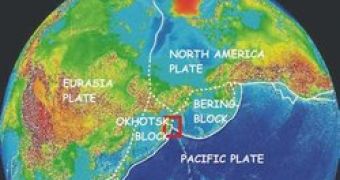For many years geologists believed that the Kamchatka Peninsula actually sits on the same tectonic plate as the mainland United States, Canada and Mexico. The North America plate extends through Alaska across the Bering Strait and into Siberia, but the question is whether it reaches as far south as Kamchatka.
But according to Jody Bourgeois of University of Washington, who studied the earthquakes and tsunamis along the Bering Sea coastline, including a magnitude 7.7 quake in 1969, Kamchatka sits atop a smaller plate, called the Okhotsk block, which is being deformed in a sort of convergence zone of tectonic plates.
Last month, on 21 and 29 April, two fairly large earthquakes happened in the region - one of magnitude 7.7 and the other of magnitude 6.6. The earthquakes were not widely reported because they did not produce widespread damage or fatalities on the sparsely populated peninsula. These earthquakes seem to add more weight to the idea that Kamchatka is on a different tectonic plate than America. Bourgeois and her colleagues examined coastal terrain on the northern part of the peninsula, an area that has been pushed up and tilted, and they judged that what they saw was caused by compression.
"What we are finding cannot be explained by a model that places Kamchatka on the North America plate," said Bourgeois.
The processes at work there, she said, are similar to those in the Cascadia region of Washington, Oregon and British Columbia. "Some of the things they might have questioned about Cascadia 20 years ago are the things they're asking about northern Kamchatka now," Bourgeois said.
The Kamchatka region is tectonically complex, with three major plates - the North America, Eurasia and Pacific - coming together around two smaller structures, the Okhotsk and Bering blocks. As the Pacific, North America and Eurasia plates are converging, the Bering block appears to be rotating. All these complex factors place pressure on the Okhotsk block and are likely responsible for the raised and tilted land the researchers found along the Kamchatka coast. "It's not just some big, general process that's causing the uplift," Bourgeois said.
Source: University of Washington

 14 DAY TRIAL //
14 DAY TRIAL //